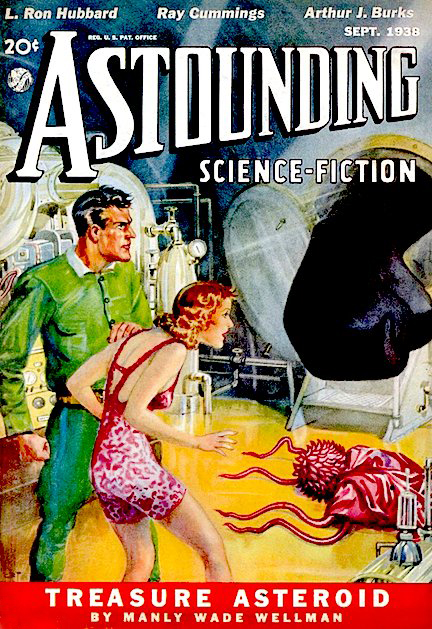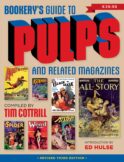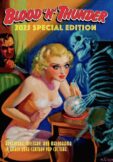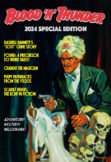EDitorial Comments
Birthday Boy: John W. Campbell
Born on this day in 1910: John W. Campbell, Jr., the writer and editor who, after Edgar Rice Burroughs and Hugo Gernsback, was almost certainly the most important man in the history of science fiction. That’s hardly a daring appraisal on my part; no less a giant of SF as Isaac Asimov once declared his former editor “the most powerful force in science fiction ever.” Campbell died in 1971, but the intervening four decades haven’t dimmed or diminished his achievements. In fact, he remains a towering figure in the genre’s history while SF’s New Wave, which prospered during his later years and for a time eclipsed the type of science fiction he championed, now seems quaintly dated—like free love and flower power.
Born in Newark, New Jersey (as I was), Campbell was something of a prodigy who attended MIT and began writing science fiction while still in his teens, breaking into Amazing Stories in 1930 before his twentieth birthday. His early yarns were space operas featuring the heroic trio Arcot, Morey, and Wade. Within a few short years he was producing stories of a more mature nature for Astounding Stories, then edited by F. Orlin Tremaine and published by Street & Smith. “Twilight” (November 1934), a melancholy short story published under the pseudonym Don A. Stuart (a name Campbell used for several years), posited the existence two millennia in the future of a triumphal human race slowly deteriorating for lack of challenge and curiosity. It was a remarkable piece of writing—thoughtful, provocative, far more stimulating than the usual pulp SF fare.
Tremaine published more yarns by Campbell and “Stuart” before making the young writer his assistant editor in 1937. Campbell worked in that capacity for a handful of months, buying most of the magazine’s fiction before becoming Astounding‘s chief editor in early 1938. His high point as Don A. Stuart was reached in the August 1938 issue with the classic “Who Goes There?”, about a shape-shifting alien systematically laying waste to a colony of scientists conducting research in the Antarctic. Most pulp aficionados know that this suspenseful novella has been filmed three times to date: in 1951 as The Thing from Another World, and in 1982 and 2011 as The Thing. Although the latter two are marginally more faithful to Campbell’s original, the first version is by far the most satisfying of the three adaptations.
The next five years saw a flurry of activity that not only made the newly rechristened Astounding Science-Fiction tops in its field but also altered the genre’s history. During this period Campbell bought the first SF stories by writers who would dominate the landscape for decades, among them Robert A. Heinlein, Theodore Sturgeon, Lester del Rey, L. Ron Hubbard, and A. E. van Vogt, to name just a handful. He eschewed the puerile space opera that had filled Astounding‘s pages when it was owned by the Clayton pulp line, demanding that his contributors produce tales which would pass muster for their solid craftsmanship as well as for their grounding in scientific principle.
Occasionally Campbell received from his stable of writers stories that were exceptionally absorbing and well written but utterly lacking in hard science. Some were out-and-out fantasies laced with irony or whimsy. To create a market for these, he persuaded Street & Smith to launch a magazine titled Unknown (later Unknown Worlds), which he also edited. Between 1939 and 1943 this outstanding magazine published some of the finest fantasy and horror stories ever to see print on pulp paper. Loved by its readers and widely respected throughout the industry, Unknown was not a top seller and fell victim to the same wartime paper shortage that forced Astounding‘s reconfiguration to digest size.
As I’ve written in The Blood ‘n’ Thunder Guide to Pulp Fiction, Campbell was most influential between late 1937, when he began buying stories for Astounding, and late 1943, when Unknown went under and Astounding began its long, slow decline. Which is not to say that the digest issues didn’t offer many great stories; they did. But the Golden Age had come and gone: Campbell had already introduced and nurtured most of the field’s superstars.
The visionary editor’s judgment began to fail him in the late Forties. He became obsessed with the “fringe science” of psionics, which encompassed such phenomena as psychokinesis and mental telepathy. Despite the absence of hard scientific evidence to support belief in “psi” abilities, Campbell encouraged his regular contributors to submit yarns built around psionics. Some, fearful of losing a well-paying regular market, complied willingly. Others became disenchanted and deserted Astounding for such competing digests as Galaxy and The Magazine of Fantasy and Science Fiction.
Street & Smith had discontinued its line of pulp magazines in 1949, with only Astounding still being published when Condé Nast bought the company in 1959. The following year Campbell changed the magazine’s title to Analog Science Fact/Science Fiction. (This was accomplished after a transition of several months in which each cover’s graphics depicted a different stage of the metamorphosis.) Strong-willed and increasingly didactic, he alienated some former supporters and contributors as the magazine’s prestige diminished. When Campbell died in 1971 he was succeeded by Ben Bova, who in 1978 relinquished the editorial reins to Stanley Schmidt, who held them until 2012. Analog survives still, with this month’s issue being number 1,000. And its legacy, overall, is a fine one—thanks to John W. Campbell, who ushered in the Golden Age of Science Fiction.
Recent Posts
- Windy City Film Program: Day Two
- Windy City Pulp Show: Film Program
- Now Available: When Dracula Met Frankenstein
- Collectibles Section Update
- Mark Halegua (1953-2020), R.I.P.
Archives
- March 2023
- July 2021
- May 2021
- March 2020
- February 2020
- December 2019
- November 2019
- October 2019
- September 2019
- August 2019
- May 2019
- April 2019
- March 2019
- February 2019
- December 2018
- November 2018
- October 2018
- August 2018
- June 2018
- February 2018
- December 2017
- October 2017
- September 2017
- August 2017
- May 2017
- April 2017
- February 2017
- September 2016
- August 2016
- July 2016
- June 2016
- November 2015
- October 2015
- September 2015
- August 2015
- July 2015
- June 2015
- May 2015
- April 2015
- March 2015
- February 2015
- January 2015
- August 2014
- July 2014
- June 2014
- May 2014
- April 2014
- January 2014
- December 2013
- September 2013
- August 2013
- July 2013
- June 2013
- May 2013
- April 2013
- March 2013
- February 2013
- January 2013
- December 2012
- October 2012
- September 2012
- August 2012
- July 2012
- June 2012
- May 2012
Categories
- Birthday
- Blood 'n' Thunder
- Blood 'n' Thunder Presents
- Classic Pulp Reprints
- Collectibles For Sale
- Conventions
- Dime Novels
- Film Program
- Forgotten Classics of Pulp Fiction
- Movies
- Murania Press
- Pulp People
- PulpFest
- Pulps
- Reading Room
- Recently Read
- Serials
- Special Events
- Special Sale
- The Johnston McCulley Collection
- Uncategorized
- Upcoming Books
- Western Movies
- Windy City pulp convention
Dealers
Events
Publishers
Resources
- Coming Attractions
- Field Guide to Wild American Pulp Artists
- MagazineArt.Org
- Mystery*File
- ThePulp.Net






